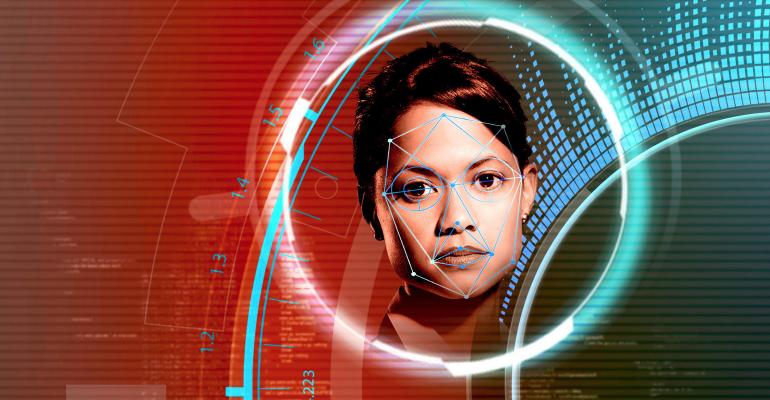Biometrics, the measurement of human characteristics for authentication purposes, is so reliable now is it trusted for airport security. For instance, JetBlue passengers can get on flights just by passing facial recognition software approval—no boarding pass required.
The question is, if a smile can get your attendees on a flight to your event, why are you making them mess around with pieces of paper and IDs when they get there? There is no reason why facial recognition technology can’t be used for conference access.
There is a basic three-step process for using it:
1. A page on your event registration website asks users to opt-in to facial recognition and upload a photo of themselves.
2. Software assigns a number to the photo, but no other identifying information and the photo is sent to a biometric company where facial measurements are noted, and then the photo is permanently deleted. This process takes only a split second.
3. The biometric info is then assigned to the number associated with an attendee, and when that person arrives at the event, a laptop camera conveys the info via Wi-Fi to an offsite database and, if the numbers match, the attendee can print a badge or simply walk into the conference.
Panos Moutafis, founder and CEO of Zenus, a facial recognition platform, says the process really is that simple. “The average LinkedIn profile pic will work, and if you can upload to social media you can upload to our platform. The image needs to be at least 150 pixels wide and 150 pixels tall in order to maintain a good level of accuracy. Passport photos are best but any selfie will work.” Last year Zenus did a pilot program in Belgium for a large roofing association and, even though the request for photos for biometric entrance happened outside the registration process, and only five days before the event, more than 200 people signed up. Moutafis says facial recognition has a 99 percent success rate, which will improve as attendees become better at supplying photos. “Our software will kick back the image if it won’t work, for example, if there are several people in the photograph. However, if you have twins coming to your event, that won’t work as their faces are too similar,” he says. If a conference is likely to attract a large number of genetically similar attendees, like twins, a 3D camera and high-resolution images could be a good investment, but for a typical group of attendees, a simple laptop and built-in camera will work.
One company that has adopted the Zenus platform is event registration provider Regie (formally Ya-Ya Regie) in the United Kingdom. Shaun Machin, technology project manager at Regie, says the impetus for using Zenus was that, “I hate standing in queues and facial recognition is a fast track into an event.” Many of Regie’s events are academic conferences where budgets are tight and personnel is limited, so using facial recognition technology makes sense as it does not require the purchase of expensive hardware. At 2017 pilot programs for about 125 of the attendees at the International Corporate Events Awards in London in July, and an academic conference for 450 attendees in December, Regie had one team member sit with a laptop and web camera set up about five feet from the delegates entering the events. Machin says, “The webcam points at people walking towards you. The image shows up on the laptop screen; it turns green when biometric measurements are recognized, and their name flashes up and you let them in.” Bonus: the person manning the laptop can greet the attendee by name; the technology is making the experience more personal, not less.
“I loved it!” says Sylvia Smith, director of sales and marketing, Grand Hyatt Erawan Bangkok, who attended the ICE Awards. “There is no fiddling with QR codes or trying to figure out where you saved the email for the event. It simply recognizes your facial features, checks you in, and prints out the badge.” A key takeaway from the pilot programs: Use the software to check photos when they are uploaded; the failure rate at the ICE Awards was entirely due to people uploading group shots, or pictures with their dogs.
Costs and Limitations
For small to midsize events, Regie has found that the expense of incorporating facial recognition into the process is mostly offset by savings on people and equipment. For example, the onsite team can be smaller because one person can check in more people faster than a traditional kiosk where attendees give their names and show IDs. While event planners typically assume each attendee will take around one minute to register, the Zenus platform can recognize an event goer walking up to check-in in less than a second, triggering a printer to print a badge further inside the registration area so that the attendee barely has to break stride walking into the event. If for some reason the person is not recognized, registration staff can still search for the name manually.
There are some limitations on how the software can be used, mostly because of privacy concerns. For example, attendees can’t maintain a profile somewhere for multiple events. They have to upload a photo for each event they attend. Moutafis says, “We have no idea who is who. The moment a picture hits our server we process it to extract the face geometry and then immediately delete the image. We have it less than a second. We only take biometric measurements up to the date of the event and delete the face measurements seven days after.” However, the “opt-in” nature of the process ensures that event planners have permission to use the technology. No photo, no foul.
In the first pilot programs launched last summer, the opt-in rate started at 10 percent for the roofing association and grew to 48 percent of the ICE Awards attendees. Since then, facial recognition has gone mainstream with the launch of the Apple’s iPhone X in November 2017, making event attendees more comfortable with the technology and raising their expectations for speed, security, and convenience at event check-ins.
To return to the main story click here, or to read the March cover story in the app or digital edition, click here.

Panos Moutafis, CEO of Zenus





